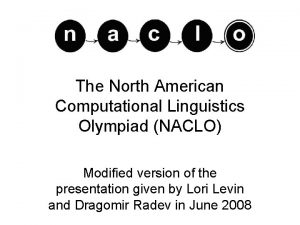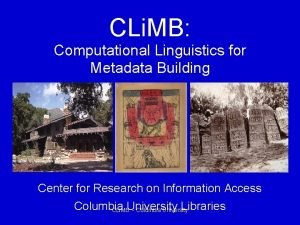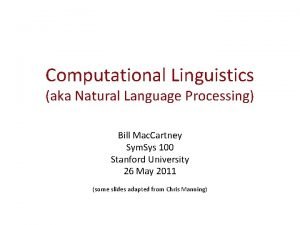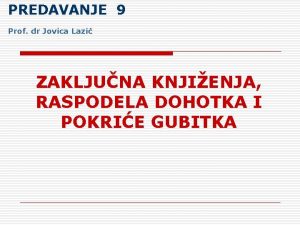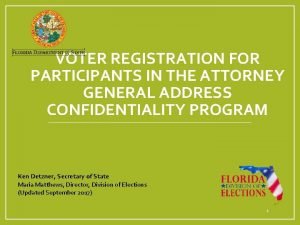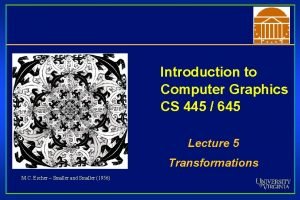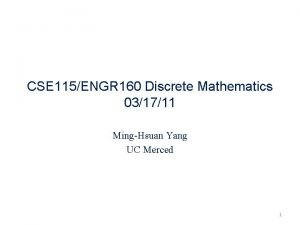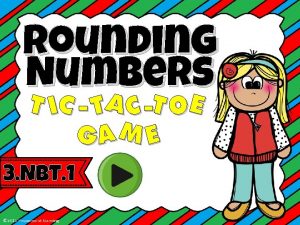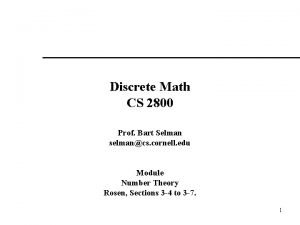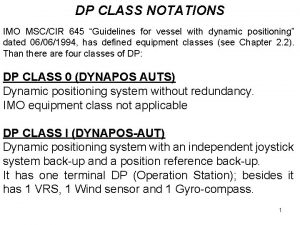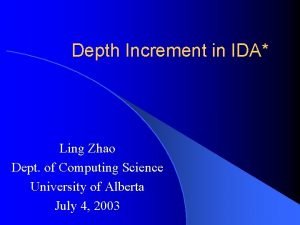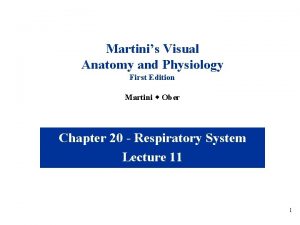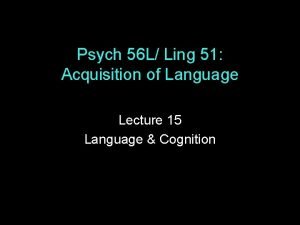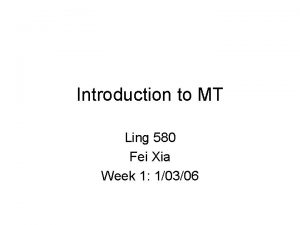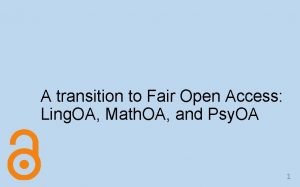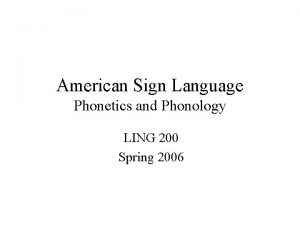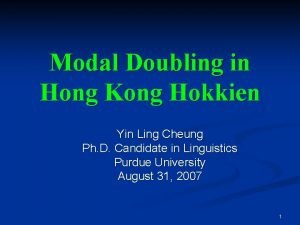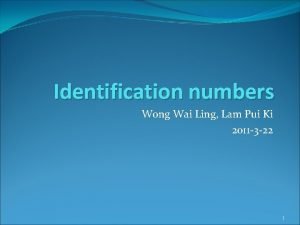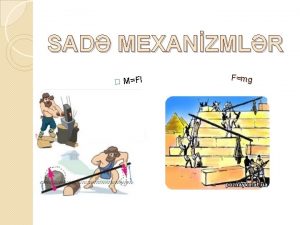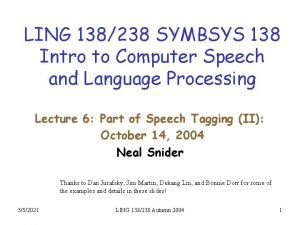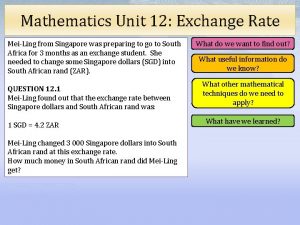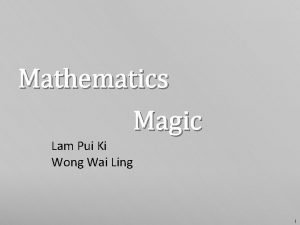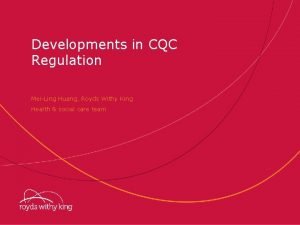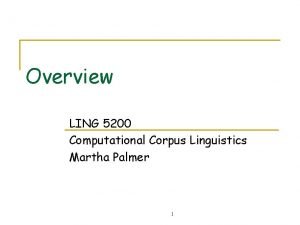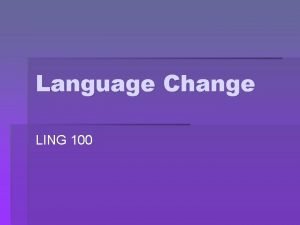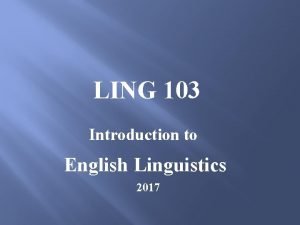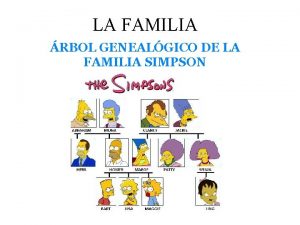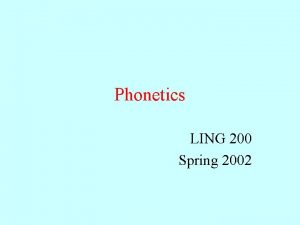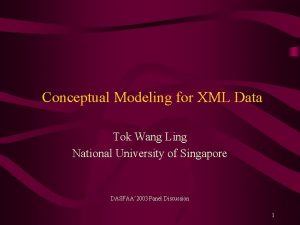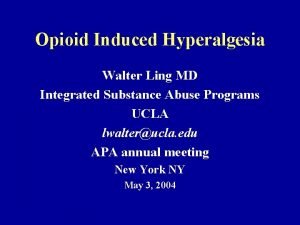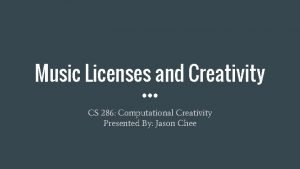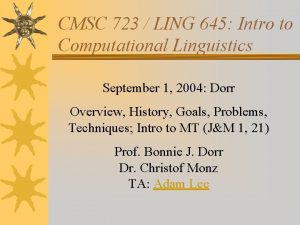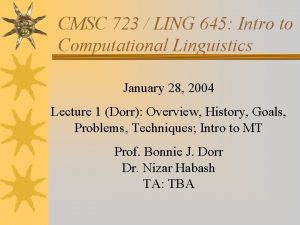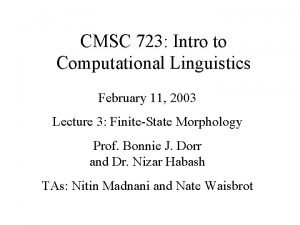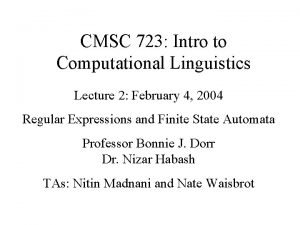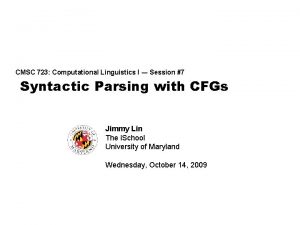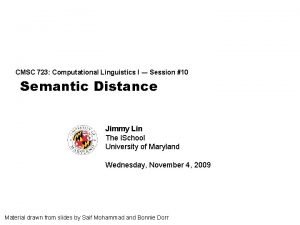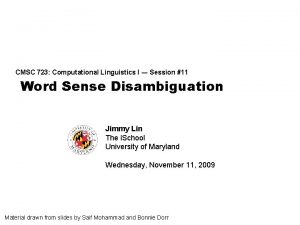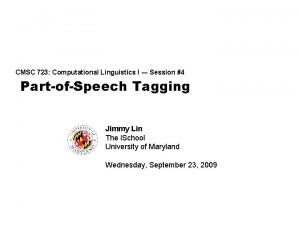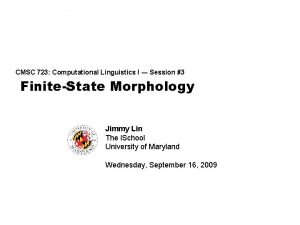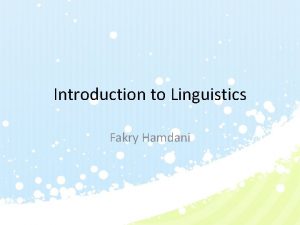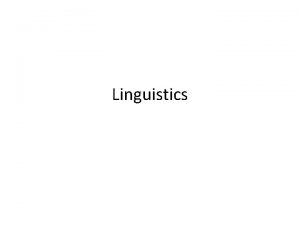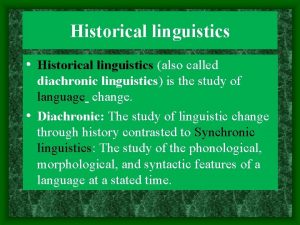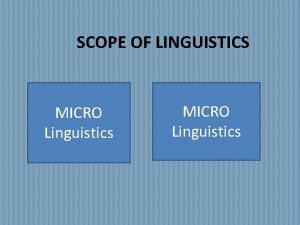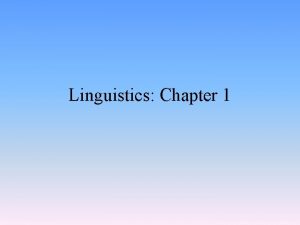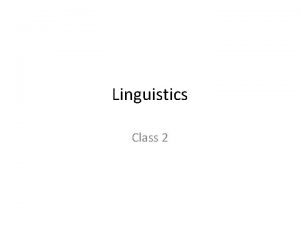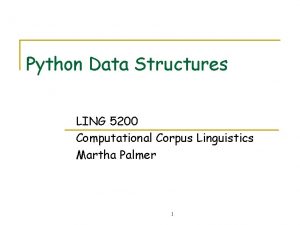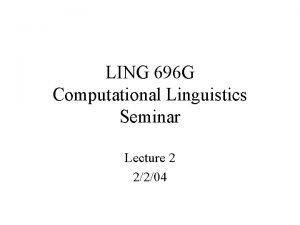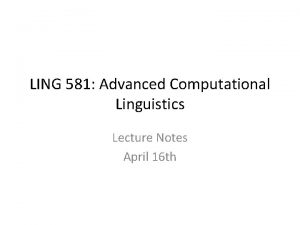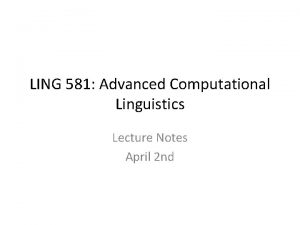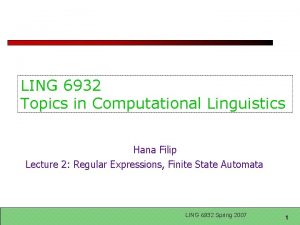CMSC 723 LING 645 Intro to Computational Linguistics












![What is the most likely word given [ni]? ¬ Compute prior P(w) Word freq(w) What is the most likely word given [ni]? ¬ Compute prior P(w) Word freq(w)](https://slidetodoc.com/presentation_image/4f601f1887224a3c612ff292733c6fbd/image-13.jpg)
![Why N-grams? ¬ Compute likelihood P([ni]|w), then multiply Word P(O|w)P(w) new . 36 . Why N-grams? ¬ Compute likelihood P([ni]|w), then multiply Word P(O|w)P(w) new . 36 .](https://slidetodoc.com/presentation_image/4f601f1887224a3c612ff292733c6fbd/image-14.jpg)
![Next Word Prediction [borrowed from J. Hirschberg] From a NY Times story. . . Next Word Prediction [borrowed from J. Hirschberg] From a NY Times story. . .](https://slidetodoc.com/presentation_image/4f601f1887224a3c612ff292733c6fbd/image-15.jpg)

































![Add-One Smoothed Bigrams P(wn|wn-1) = C(wn-1 wn)/C(wn-1) P′(wn|wn-1) = [C(wn-1 wn)+1]/[C(wn-1)+V] Add-One Smoothed Bigrams P(wn|wn-1) = C(wn-1 wn)/C(wn-1) P′(wn|wn-1) = [C(wn-1 wn)+1]/[C(wn-1)+V]](https://slidetodoc.com/presentation_image/4f601f1887224a3c612ff292733c6fbd/image-49.jpg)





- Slides: 54

CMSC 723 / LING 645: Intro to Computational Linguistics February 25, 2004 Lecture 5 (Dorr): Intro to Probabilistic NLP and N-grams (chap 6. 1 -6. 3) Prof. Bonnie J. Dorr Dr. Nizar Habash TA: Nitin Madnani, Nate Waisbrot

Why (not) Statistics for NLP? ¬Pro – Disambiguation – Error Tolerant – Learnable ¬Con – Not always appropriate – Difficult to debug

Weighted Automata/Transducers ¬ Speech recognition: storing a pronunciation lexicon ¬ Augmentation of FSA: Each arc is associated with a probability

Pronunciation network for “about”

Noisy Channel

Probability Definitions ¬ Experiment (trial) – Repeatable procedure with well-defined possible outcomes ¬ Sample space – Complete set of outcomes ¬ Event – Any subset of outcomes from sample space ¬ Random Variable – Uncertain outcome in a trial

More Definitions ¬Probability – How likely is it to get a particular outcome? – Rate of getting that outcome in all trials Probability of drawing a spade from 52 well-shuffled playing cards: ¬Distribution: Probabilities associated with each outcome a random variable can take – Each outcome has probability between 0 and 1 – The sum of all outcome probabilities is 1.

Conditional Probability ¬What is P(A|B)? ¬First, what is P(A)? – P(“It is raining”) =. 06 ¬Now what about P(A|B)? – P(“It is raining” | “It was clear 10 minutes ago”) =. 004 A A, B B Note: P(A, B)=P(A|B) · P(B) Also: P(A, B) = P(B, A)

Independence ¬ What is P(A, B) if A and B are independent? ¬ P(A, B)=P(A) · P(B) iff A, B independent. – P(heads, tails) = P(heads) · P(tails) =. 5 ·. 5 =. 25 – P(doctor, blue-eyes) = P(doctor) · P(blue-eyes) =. 01 ·. 2 =. 002 ¬ What if A, B independent? – P(A|B)=P(A) iff A, B independent – Also: P(B|A)=P(B) iff A, B independent

Bayes Theorem • Swap the order of dependence • Sometimes easier to estimate one kind of dependence than the other

What does this have to do with the Noisy Channel Model? (O) (H) P(O|H) Best H = argmax P(H|O) = argmax H H Best H likelihood prior

Noisy Channel Applied to Word Recognition ¬argmaxw P(w|O) = argmaxw P(O|w) P(w) ¬Simplifying assumptions – pronunciation string correct – word boundaries known ¬Problem: – Given [n iy], what is correct dictionary word? ¬What do we need? [ni]: knee, neat, need, new
![What is the most likely word given ni Compute prior Pw Word freqw What is the most likely word given [ni]? ¬ Compute prior P(w) Word freq(w)](https://slidetodoc.com/presentation_image/4f601f1887224a3c612ff292733c6fbd/image-13.jpg)
What is the most likely word given [ni]? ¬ Compute prior P(w) Word freq(w) P(w) new 2625 . 001 neat 338 . 00013 need 1417 . 00056 knee 61 . 000024 ¬ Now compute likelihood P([ni]|w), then multiply Word P(O|w)P(w) new . 36 . 001 . 00036 neat . 52 . 00013 . 000068 need . 11 . 00056 . 000062 knee 1. 000024
![Why Ngrams Compute likelihood Pniw then multiply Word POwPw new 36 Why N-grams? ¬ Compute likelihood P([ni]|w), then multiply Word P(O|w)P(w) new . 36 .](https://slidetodoc.com/presentation_image/4f601f1887224a3c612ff292733c6fbd/image-14.jpg)
Why N-grams? ¬ Compute likelihood P([ni]|w), then multiply Word P(O|w)P(w) new . 36 . 001 . 00036 P([ni]|new)P(new) neat . 52 . 00013 . 000068 P([ni]|neat)P(neat) need . 11 . 00056 . 000062 P([ni]|need)P(need) knee 1. 000024 P([ni]|knee)P(knee) ¬Unigram approach: ignores context ¬Need to factor in context (n-gram) - Use P(need|I) instead of just P(need) - Note: P(new|I) < P(need|I)
![Next Word Prediction borrowed from J Hirschberg From a NY Times story Next Word Prediction [borrowed from J. Hirschberg] From a NY Times story. . .](https://slidetodoc.com/presentation_image/4f601f1887224a3c612ff292733c6fbd/image-15.jpg)
Next Word Prediction [borrowed from J. Hirschberg] From a NY Times story. . . – Stocks plunged this …. – Stocks plunged this morning, despite a cut in interest rates by the Federal Reserve, as Wall. . . – Stocks plunged this morning, despite a cut in interest rates by the Federal Reserve, as Wall Street began

Next Word Prediction (cont) – Stocks plunged this morning, despite a cut in interest rates by the Federal Reserve, as Wall Street began trading for the first time since last … – Stocks plunged this morning, despite a cut in interest rates by the Federal Reserve, as Wall Street began trading for the first time since last Tuesday's terrorist attacks.

Human Word Prediction ¬Domain knowledge ¬Syntactic knowledge ¬Lexical knowledge

Claim ¬A useful part of the knowledge needed to allow Word Prediction can be captured using simple statistical techniques. ¬Compute: – probability of a sequence – likelihood of words co-occurring

Why would we want to do this? ¬Rank the likelihood of sequences containing various alternative hypotheses ¬Assess the likelihood of a hypothesis

Why is this useful? ¬Speech recognition ¬Handwriting recognition ¬Spelling correction ¬Machine translation systems ¬Optical character recognizers

Handwriting Recognition ¬Assume a note is given to a bank teller, which the teller reads as I have a gub. (cf. Woody Allen) ¬NLP to the rescue …. – gub is not a word – gun, gum, Gus, and gull are words, but gun has a higher probability in the context of a bank

Real Word Spelling Errors ¬ They are leaving in about fifteen minuets to go to her house. ¬ The study was conducted mainly be John Black. ¬ The design an construction of the system will take more than a year. ¬ Hopefully, all with continue smoothly in my absence. ¬ Can they lave him my messages? ¬ I need to notified the bank of…. ¬ He is trying to fine out.

For Spell Checkers ¬Collect list of commonly substituted words – piece/peace, whether/weather, their/there. . . ¬Example: “On Tuesday, the whether …’’ “On Tuesday, the weather …”

Language Model ¬Definition: Language model is a model that enables one to compute the probability, or likelihood, of a sentence S, P(S). ¬Let’s look at different ways of computing P(S) in the context of Word Prediction

Word Prediction: Simple vs. Smart ¬ Simple: Every word follows every other word w/ equal probability (0 -gram) – Assume |V| is the size of the vocabulary – Likelihood of sentence S of length n is = 1/|V| × 1/|V| … × 1/|V| n times – If English has 100, 000 words, probability of each next word is 1/100000 =. 00001 ¬ Smarter: Probability of each next word is related to word frequency (unigram) – Likelihood of sentence S = P(w 1) × P(w 2) × … × P(wn) – Assumes probability of each word is independent of probabilities of other words. ¬ Even smarter: Look at probability given previous words (N-gram) – Likelihood of sentence S = P(w 1) × P(w 2|w 1) × … × P(wn|wn-1) – Assumes probability of each word is dependent on probabilities of other words.

Chain Rule ¬ Conditional Probability – P(A 1, A 2) = P(A 1) · P(A 2|A 1) ¬ The Chain Rule generalizes to multiple events – P(A 1, …, An) = P(A 1) P(A 2|A 1) P(A 3|A 1, A 2)…P(An|A 1…An-1) ¬ Examples: – P(the dog) = P(the) P(dog | the) – P(the dog bites) = P(the) P(dog | the) P(bites| the dog)

Relative Frequencies and Conditional Probabilities ¬ Relative word frequencies are better than equal probabilities for all words – In a corpus with 10 K word types, each word would have P(w) = 1/10 K – Does not match our intuitions that different words are more likely to occur (e. g. the) ¬ Conditional probability more useful than individual relative word frequencies – Dog may be relatively rare in a corpus – But if we see barking, P(dog|barking) may be very large

For a Word String ¬ In general, the probability of a complete string of words w 1…wn is: n P(w 1 ) = P(w 1)P(w 2|w 1)P(w 3|w 1. . w 2)…P(wn|w 1…wn-1) = ¬But this approach to determining the probability of a word sequence is not very helpful in general….

Markov Assumption ¬ How do we compute P(wn|w 1 n-1)? Trick: Instead of P(rabbit|I saw a), we use P(rabbit|a). – This lets us collect statistics in practice – A bigram model: P(the barking dog) = P(the|<start>)P(barking|the)P(dog|barking) ¬ Markov models are the class of probabilistic models that assume that we can predict the probability of some future unit without looking too far into the past n n – Specifically, for N=2 (bigram): P(w 1) ≈ Π P(wk|wk-1) k=1 ¬ Order of a Markov model: length of prior context – bigram is first order, trigram is second order, …

Counting Words in Corpora ¬What is a word? – e. g. , are cat and cats the same word? – September and Sept? – zero and oh? – Is seventy-two one word or two? AT&T? – Punctuation? ¬How many words are there in English? ¬Where do we find the things to count?

Corpora ¬ Corpora are (generally online) collections of text and speech ¬ Examples: – – – Brown Corpus (1 M words) Wall Street Journal and AP News corpora ATIS, Broadcast News (speech) TDT (text and speech) Switchboard, Call Home (speech) TRAINS, FM Radio (speech)

Training and Testing ¬ Probabilities come from a training corpus, which is used to design the model. – overly narrow corpus: probabilities don't generalize – overly general corpus: probabilities don't reflect task or domain ¬ A separate test corpus is used to evaluate the model, typically using standard metrics – held out test set – cross validation – evaluation differences should be statistically significant

Terminology ¬ Sentence: unit of written language ¬ Utterance: unit of spoken language ¬ Word Form: the inflected form that appears in the corpus ¬ Lemma: lexical forms having the same stem, part of speech, and word sense ¬ Types (V): number of distinct words that might appear in a corpus (vocabulary size) ¬ Tokens (N): total number of words in a corpus ¬ Types seen so far (T): number of distinct words seen so far in corpus (smaller than V and N)

Simple N-Grams ¬An N-gram model uses the previous N-1 words to predict the next one: P(wn | wn-N+1 wn-N+2… wn-1 ) – unigrams: P(dog) – bigrams: P(dog | big) – trigrams: P(dog | the big) – quadrigrams: P(dog | chasing the big)

Using N-Grams ¬ Recall that – N-gram: P(wn|w 1 n-1) ≈ P(wn|wn-1 n-N+1) – Bigram: P(wn 1) n ≈Π P(wk|wk-1) k=1 ¬ For a bigrammar – P(sentence) can be approximated by multiplying all the bigram probabilities in the sequence ¬ Example: P(I want to eat Chinese food) = P(I | <start>) P(want | I) P(to | want) P(eat | to) P(Chinese | eat) P(food | Chinese)

A Bigram Grammar Fragment from BERP Eat on . 16 Eat Thai . 03 Eat some . 06 Eat breakfast . 03 Eat lunch . 06 Eat in . 02 Eat dinner . 05 Eat Chinese . 02 Eat at . 04 Eat Mexican . 02 Eat a . 04 Eat tomorrow . 01 Eat Indian . 04 Eat dessert . 007 Eat today . 03 Eat British . 001

Additional BERP Grammar <start> I’d <start> Tell <start> I’m . 25. 06. 04. 02 Want some Want Thai To eat To have . 04. 01. 26. 14 I want I would I don’t I have Want to Want a . 32. 29. 08. 04. 65. 05 To spend To be British food British restaurant British cuisine British lunch . 09. 02. 60. 15. 01

Computing Sentence Probability ¬ P(I want to eat British food) = P(I|<start>) P(want|I) P(to|want) P(eat|to) P(British|eat) P(food|British) =. 25×. 32×. 65×. 26×. 001×. 60 =. 000080 ¬ vs. I want to eat Chinese food =. 00015 ¬ Probabilities seem to capture “syntactic” facts, “world knowledge” – eat is often followed by a NP – British food is not too popular ¬ N-gram models can be trained by counting and normalization

BERP Bigram Counts I Want To Eat Chinese Food lunch I 8 1087 0 13 0 0 0 Want 3 0 786 0 6 8 6 To 3 0 10 860 3 0 12 Eat 0 0 2 0 19 2 52 Chinese 2 0 0 120 1 Food 19 0 17 0 0 Lunch 4 0 0 1 0

BERP Bigram Probabilities: Use Unigram Count ¬Normalization: divide bigram count by unigram count of first word. I Want To Eat Chinese Food Lunch 3437 1215 3256 938 213 1506 459 ¬Computing the probability of I I – P(I|I) = C(I I)/C(I) = 8 / 3437 =. 0023 ¬A bigrammar is an Nx. N matrix of probabilities, where N is the vocabulary size

Learning a Bigram Grammar ¬The formula P(wn|wn-1) = C(wn-1 wn)/C(wn-1) is used for bigram “parameter estimation” ¬Relative Frequency ¬Maximum Likelihood Estimation (MLE): Parameter set maximizes likelihood of training set T given model M — P(T|M).

What do we learn about the language? ¬ What's being captured with. . . – – – P(want | I) =. 32 P(to | want) =. 65 P(eat | to) =. 26 P(food | Chinese) =. 56 P(lunch | eat) =. 055 ¬ What about. . . – P(I | I) =. 0023 – P(I | want) =. 0025 – P(I | food) =. 013

Approximating Shakespeare ¬ As we increase the value of N, the accuracy of the n-gram model increases ¬ Generating sentences with random unigrams. . . – Every enter now severally so, let – Hill he late speaks; or! a more to leg less first you enter ¬ With bigrams. . . – What means, sir. I confess she? then all sorts, he is trim, captain. – Why dost stand forth thy canopy, forsooth; he is this palpable hit the King Henry.

More Shakespeare ¬Trigrams – Sweet prince, Falstaff shall die. – This shall forbid it should be branded, if renown made it empty. ¬Quadrigrams – What! I will go seek the traitor Gloucester. – Will you not tell me who I am?

Dependence of N-gram Models on Training Set ¬ There are 884, 647 tokens, with 29, 066 word form types, in about a one million word Shakespeare corpus ¬ Shakespeare produced 300, 000 bigram types out of 844 million possible bigrams: so, 99. 96% of the possible bigrams were never seen (have zero entries in the table). ¬ Quadrigrams worse: What's coming out looks like Shakespeare because it is Shakespeare. ¬ All those zeroes are causing problems.

N-Gram Training Sensitivity ¬If we repeated the Shakespeare experiment but trained on a Wall Street Journal corpus, there would be little overlap in the output ¬This has major implications for corpus selection or design unigram: Months the my and issue of year foreign new exchange’s september were recession exchange new endorsed a acquire to six executives. bigram: Last December through the way to preserve the Hudson corporation N. B. E. C. Taylor would seem to complet the major central planners one point five percent of U. S. E has laready old M. X. … trigram: They also point to ninety nine point six billion dollars from twohundred four oh six three percent …

Some Useful Empirical Observations ¬ A small number of events occur with high frequency ¬ A large number of events occur with low frequency ¬ You can quickly collect statistics on the high frequency events ¬ You might have to wait an arbitrarily long time to get valid statistics on low frequency events ¬ Some of the zeroes in the table are really zeroes. But others are simply low frequency events you haven't seen yet. How to fix?

Smoothing Techniques ¬ Every ngram training matrix is sparse, even for very large corpora (Zipf’s law) ¬ Computing perplexity requires non-zero probabilities ¬ Unsmoothed: P(wi)=ci/N ¬ Solution: estimate the likelihood of unseen ngrams ¬ Add-one smoothing: – – Add 1 to every ngram count Normalize by N/(N+V) Smoothed count is: ci′= (ci+1) · N/(N+V) Smoothed probability: P′(wi) = ci′/N
![AddOne Smoothed Bigrams Pwnwn1 Cwn1 wnCwn1 Pwnwn1 Cwn1 wn1Cwn1V Add-One Smoothed Bigrams P(wn|wn-1) = C(wn-1 wn)/C(wn-1) P′(wn|wn-1) = [C(wn-1 wn)+1]/[C(wn-1)+V]](https://slidetodoc.com/presentation_image/4f601f1887224a3c612ff292733c6fbd/image-49.jpg)
Add-One Smoothed Bigrams P(wn|wn-1) = C(wn-1 wn)/C(wn-1) P′(wn|wn-1) = [C(wn-1 wn)+1]/[C(wn-1)+V]

Add-One Smoothing Flaw ci ci′=(ci+1)

Discounted Smoothing: Witten-Bell ¬ Witten-Bell Discounting – A zero ngram is just an ngram you haven’t seen yet… – Model unseen bigrams by the ngrams you’ve only seen once: total number of n-gram types in the data. – Total probability of unseen bigrams estimated as: T/(N+T) – View training corpus as series of events, one for each token (N) and one for each new type (T): MLE. – We can divide the probability mass equally among unseen bigrams. Let Z = number of unseen n-grams: ci′ = (T/Z) · N/(N+T) if ci=0; else ci′ = ci · N/(N+T)

Witten-Bell Bigram Counts ci ci′=(ci+1) ci′ = T/Z · ci · if ci=0 otherwise

Other Discounting Methods ¬Good-Turing Discounting – Re-estimate amount of probability mass for zero (or low count) ngrams by looking at ngrams with higher counts – Estimate – Assumes: • word bigrams follow a binomial distribution • We know number of unseen bigrams (Vx. V-seen)

Readings for next time ¬J&M Chapter 7. 1 -7. 3
 Computational linguistics olympiad
Computational linguistics olympiad Columbia computational linguistics
Columbia computational linguistics Chomsky computational linguistics
Chomsky computational linguistics Xkcd computational linguistics
Xkcd computational linguistics Zatvaranje konta 723
Zatvaranje konta 723 723 truman ave tallahassee fl
723 truman ave tallahassee fl Opwekking 595
Opwekking 595 You purchase 723 shares of nike
You purchase 723 shares of nike Ic 723 pin diagram
Ic 723 pin diagram History of applied linguistics
History of applied linguistics Language
Language 645 rounded to the nearest hundred
645 rounded to the nearest hundred 645 transformations
645 transformations Use algorithm 5 to find 11^644 mod 645
Use algorithm 5 to find 11^644 mod 645 Approximate 645 to the nearest hundred
Approximate 645 to the nearest hundred 3^644 mod 645
3^644 mod 645 Dp class 2 requirements
Dp class 2 requirements Tt-p-645
Tt-p-645 Erin ling
Erin ling Ida ling
Ida ling Picture of tree in lung
Picture of tree in lung False belief test
False belief test Mtling
Mtling Dr ng li ling
Dr ng li ling Jin ling cigarettes
Jin ling cigarettes Ling internet
Ling internet Shi sheng ling
Shi sheng ling Ling adder
Ling adder Ling
Ling Ling oa
Ling oa Ling 200
Ling 200 Cheung yin ling
Cheung yin ling Example of long term plans
Example of long term plans Wai ling lam
Wai ling lam Nien-ling wacker
Nien-ling wacker Tərpənən və tərpənməz blok
Tərpənən və tərpənməz blok Not wild animals
Not wild animals Ling rolled
Ling rolled Ling138
Ling138 Mei-ling from singapore was preparing
Mei-ling from singapore was preparing Wai ling lam
Wai ling lam Mei-ling huang
Mei-ling huang Ling oa
Ling oa Contribution of archibald mclaren
Contribution of archibald mclaren 施玲玲
施玲玲 Ling
Ling Ling 100
Ling 100 Right marginal artery
Right marginal artery Ling
Ling Primas de marge simpson
Primas de marge simpson Ling 200
Ling 200 Wang ling relationship
Wang ling relationship Ling simpson
Ling simpson Walter ling
Walter ling Computational creativity market trends
Computational creativity market trends
